This month we submerge ourselves in the science of tracking sharks. How do we follow them, where do they go, and what do they get up to when we're not watching? We catch up with Ecocean's Brad Norman to find out how he was inspired by the stars to help track the biggest fish in the seas. Mahmood Shivji from the Guy Harvey Research Institute tells us about how cutting edge genetic tools are helping to track the trade in sharks fins. And Boris Worm chooses our Critter of the Month.
In this episode
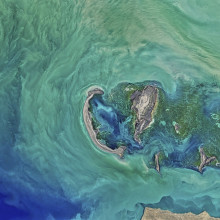
03:55 - Super-efficient Salps help lock up CO2
Super-efficient Salps help lock up CO2
They may look like rather unexciting little bags of jelly, but salps may be the most efficient filter feeders in the ocean. According to a study just out in the journal PNAS, this could make them important players in the draw down of carbon from surface waters into the deep sea...
Salps are a variety of tunicate, a group of animals that also includes sea squirts and are, surprisingly, evolutionarily related to vertebrates. They are filter feeders a few centimetres long that are either solitary or live in chains that can be hundreds of salps long.
Until now, scientists thought that although they were very efficient at filter feeding using a mucous 'net' type structure, they could only catch food that was larger than the holes of the net - a fairly sensible assumption to make if you think about things like fishing nets and sieves. But Kelly Sutherland and her colleagues used lab experiments where they offered salps specifically sized polystyrene balls of 0.5 to 3 micrometers in diameter and showed that even the smallest particles were picked up at a higher rate than expected.
So it turns out that salps can eat food in a huge range of sizes - in the words of one of the paper's authors, 'like being able to eat everything from the size of a mouse to a horse!'. And this is extremely beneficial as it allows salps to thrive on a wide range of different phytoplankton, zooplankton and other particles.
Another really interesting suggestion made by the authors is that the salps could be contributing more than expected to take down of carbon into the deep ocean. Because they consume tiny, tiny particles and then combine them into much larger faecal pellets, that allows carbon to be taken out of the top layer of the seawater and sink down to the ocean floor.
So, efficient and important for the environment - again proof that you shouldn't judge an animal by its looks!
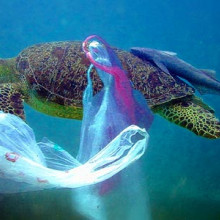
06:00 - American Samoa bans the bag
American Samoa bans the bag
There's good news for the oceans, with the announcement that American Samoa, a group of Pacific Islands, will ban the use of all plastic bags next year.
It's a bold step that has been made at a local level in various countries, including the town of Modbury in the UK, Fort McMurray in Canada, and the American city, San Francisco - while various countries and corporations, including China, are trying to stop shops from handing out free plastic bags.
 Plastics have only been around for a few decades, so the scary truth is that at the moment we don't really know how long it takes for them to break down once they have been thrown away. What we do know is that plastic bags are a major source of pollution in the oceans. Sea turtles mistake them for jellyfish and eat them, choking themselves in the process. They can entangle all sorts of other marine life, and even if they do break down into smaller pieces, these can leach nasty chemicals into the environment.
Plastics have only been around for a few decades, so the scary truth is that at the moment we don't really know how long it takes for them to break down once they have been thrown away. What we do know is that plastic bags are a major source of pollution in the oceans. Sea turtles mistake them for jellyfish and eat them, choking themselves in the process. They can entangle all sorts of other marine life, and even if they do break down into smaller pieces, these can leach nasty chemicals into the environment.
There's no doubt at all that making and throwing away fewer plastic bags has to be a positive step for the oceans.
Well done American Samoa. It was a shame that the state of California in the US voted against taking the same ban.
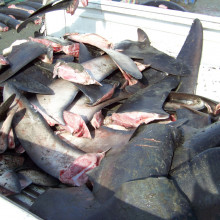
07:28 - Genetic tools to track the shark fin trade
Genetic tools to track the shark fin trade
with Mahmood Shivji, Save Our Seas Shark Center and the Guy Harvey Research Institute, NOVA Southeastern University
A major threat to sharks the world over is the trade in their fins to be made into an expensive delicacy: sharks fins soup. Mahmood Shivji tells us about his work using molecular tools to track the shark fin trade - DNA extracted from a dismembered fin can tell us not only which species it came from but where in the ocean the shark lived. This is providing a powerful tool in monitoring and managing the trade and protecting threatened shark populations.
 It's not just sharks that are targeted by the fin trade - their relatives, the bizarre-looking sawfish, are in even worse trouble.
It's not just sharks that are targeted by the fin trade - their relatives, the bizarre-looking sawfish, are in even worse trouble.
Find out more
Mahmood Shivji
Guy Harvey Research Institute
Save Our Seas,
Sharks International Conference, 2010
Sawfish info from
Elasmoworld
Mahmood - We have some really good quantitative estimates now that tens of millions of sharks are being killed a year to supply the global shark fin trade. And in fact it could be as many as 73 million sharks a year. And that's a staggering number. No one is keeping track of which species and what numbers of each species are being killed worldwide to supply this trade.
The best way currently to get a handle on this type of information is to actually monitor fin markets.
Helen - How do you go from having a dismembered, dried shark fin to developing a genetic tool that's going to help us identify which species it came from?
Mahmood - In a way it's somewhat analogous, although I must add not identical, to DNA methods that are used in human crime cases.
The way we do this, over the past decade or so we've established an extensive reference database of DNA markers for 80 different shark species. We established this by collecting tissue samples with the help of colleagues around the world form wild sharks in the field as well as from sharks that have been landed in fishing ports.
Now we have this database of what are really species-specific DNA markers it's become really quite simple. It's just a matter of getting the fin or the meat from the market, analysing the DNA and then matching up the DNA from this body part to the reference database to identify which species that fin or that body part came from.
Helen - What sort of species have you been working with and what sort of things have your studies been showing us?
 Mahmood - The global fin trade consists of mostly around 50 shark species and you know some species are more common than others. As an example we did a market study with Shelley Clarke at Imperial College in the UK and showed that fins form blue sharks, short fin mako sharks, silky sharks and hammerhead sharks are the most common in the trade.
Mahmood - The global fin trade consists of mostly around 50 shark species and you know some species are more common than others. As an example we did a market study with Shelley Clarke at Imperial College in the UK and showed that fins form blue sharks, short fin mako sharks, silky sharks and hammerhead sharks are the most common in the trade.
But surprisingly we also found fins form white sharks and both these species have small populations worldwide.
It turns out sharks are not the only elasmobranchs whose fins are valued in the fin trade. In fact there is another group called sawfishes. Sawfishes are a type of ray, they're related to sharks. Sawfishes are those rays that have a long nose or rostrum, if you will, that has teeth on it. Sawfish populations have declined worldwide dramatically to a point where all currently six described species urgently need to be protected from fishing. And as a result all known sawfish species are now listed on CITES, with 5 actually listed on CITES appendix I. And what that means is that international trade in these species is now illegal for countries that are signatories to CITES, which is most countries.
Helen - I take it there is still sawfish trade going on if your genetic studies are showing them up in trade?
Mahmood - The most highly valued fins in the trade are actually from sawfishes. Some sawfishes have really large fins and as a result of overfishing, overfishing for the fin trade, as well as habitat destruction sawfishes have really taken the brunt of our overexploitation and their populations have declined tremendously.
Now, the problem is once you have a detached fin it becomes difficult to tell whether it's from a sawfish or whether it's from a legal to harvest shark. So what we've done is develop a quick genetics test that can distinguish fins form sawfishes from fins from other sharks and rays. It's sort of a generic test, it says that fin is from a sawfish and not from a shark or any other type of ray.
The beauty in this test is that it's really, really quick and therefore can be used practically.
Helen - You've also been using genetics to pin down exactly what parts of the oceans they come from. Could you tell us a bit more about that?
Mahmood - What we did was that we actually looked at stock structure of scalloped hammerheads in the North and Southwest Atlantic. And we were able to find a clear genetic signature that would distinguish scalloped hammerheads from the Northwest Atlantic versus the Caribbean versus the Southwest Atlantic. We then went to the fins trade. We first identified fins are being from scalloped hammerheads. We then asked if some of those fins were coming from the Western Atlantic and we were able to match them up.
And the reason that's important is because first of all it's sort of a proof of concept that you can tell not only what species the fin came from but what part of the world that fin came from. And it turns out in the Western Atlantic, scalloped hammerheads are severely overfished, in fact their populations have really crashed. And so the fact that we found fins from overfished populations in the fin trade tells you that there's a direct pathway, a direct channel from the Western Atlantic to Asian markets. And therefore more attention needs to be paid in the Western Atlantic to protect these stocks.
Helen - Because your lab is also working on physically tracking sharks with various types of tags. How is that helping to build up a picture of where sharks move and how they use the oceans?
Mahmood - There's a critical need for migratory pathways of sharks and where sharks give birth and where they mate. One of the best ways to obtain that information is by tracking sharks. By putting on satellite tags, it will allow fine scale tracking of sharks over long periods of time. And what we're hoping to get at is to find first of all if there are specific patterns of migratory corridors, if you will, that individual species are moving along at certain times of the years. That's number one.
Number two is to find out if females are ending up in areas where they give birth. Number three is to see whether both males and females are ending up in certain areas of the world at certain times where they're mating.
If we can find these places, define these corridors, and find these pupping and mating places, then those places can be protected in terms of fishing to make sure that these very sensitive demographic populations are not being fished.
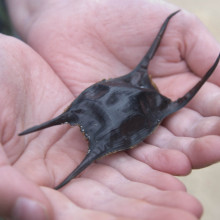
14:20 - The Great Egg Case Hunt
The Great Egg Case Hunt
with John Richardson, The Shark Trust, and Sonia Revelley, Natural England
Also known as "Mermaid's purses", the empty egg cases of skates and rays wash up on beaches all around the world, leaving a useful calling card to help track down these threatened relatives of sharks.
The Great Egg Case hunt is a project pioneered by The Shark Trust, with individual hunts run by various other conservation groups around the UK.
We join a Great Egg Case Hunt at Hunstanton Beach on the north Norfolk coast organised by Natural England and Borough Council of King's Lynn and West Norfolk. Sonia Revelley from Natural England introduces us to the beachside hunt, while John Richardson from The Shark Trust tells us more about the science and conservation messages behind the project.
Find out more
The Great Egg Case Hunt
The Shark Trust
Natural England
Helen - Sonia, tell us, what are we looking for today?
Sonia - Today we're going to go down to the beach and we're going to look for mermaids' purses. They resemble big black giant ravioli cases and basically they are the egg cases of skates found living in UK waters. So, that's what we're doing today.
Helen - And we just look around on the beach. Is there anywhere that's particularly good to look for these things?
Sonia - Best place to look for egg cases is basically on the strand line, the highest point where the tide deposits all the seaweed and debris from the ocean. Against the base of the cliff at Hunstanton and against the base of the sea wall.
Helen - That sounds fantastic. Let's go see what we can find.
Have you guys found anything? What have you got?
That definitely looks like an egg case to me. Where did you find it? At the top of the beach?
Egg case hunter - Yes, at the top, near the wall.
Egg case hunter 2 - And I found lots of mussels for tea tonight.
Helen - Excellent. So you've got your dinner as well. Are they easy to find, the egg cases?
Egg case hunter 2 - Noooo.
Helen - Where's the best place to look for them, do you think?
Egg case hunter 2 - Near the edge, in the sea weed.
Helen - In the sea weed? Excellent, because I haven't found any yet. I'm not very good at this.
Oh my goodness. Look at this! There's a whole box full of them! Who found them? Did you find these?
Egg case hunter 3 - I found a fossil.
Helen - And a fossil. This is fantastic. What a great trove, a great treasure trove. You must have, there must be about thirty in there. Keep up the good work.
So, has today been a success? Did you find what you were looking for Sonia?
Sonia - Yes, today has definitely been a success. We've had quite a few mermaids' purses brought back. With two separate families we've managed to identify. One definitely spotted ray mermaids' purse, and one definite thornback ray mermaid's purse.
We're very happy. I've now got to go back home and try and identify all the others and then send them back to the shark trust. But no, it's been a very successful day.
John - The prime reason behind it is to really raise the profile of skates and rays in the UK. For adults of a lot of the marine species they do have issues facing them in terms of conservation, they probably get the least press of all. People know very little about them. And is a great chance for the shark trust and everyone who takes part in it to raise their profile in the public eye, get people thinking about them and the issues facing them.
Helen - What kind of issues are these species facing?
John - Overfishing tends to be the problem. They don't have a very high reproductive rate and when you get bottom trawlers and other commercial fishing operations in the area, if we're not careful and don't have a sufficient amount of research on these populations it would be very easy to wipe out regional populations or to make a real dint in their numbers to the point where they struggle to reproduce.
Helen - What are you finding with this data, and how do you hope ideally this will actually help to protect these species?
John - We're still piecing it together. We do have over 17,000 individual records so we have a lot of data. We're still working with government organisations such as Cefas, which is more of a fisheries science group. Where we identify areas where skates and rays are perhaps breeding, where there are nursery areas that are really important to future populations of these species, once we've identified these perhaps we can look at getting some protection in there, perhaps from fishing, from recreational angling. We can stop, well, we can try and stop aggregate mining and dumping of dredge spoil, all these things that really do have impacts on skate and ray populations.
Helen - And this isn't just in the UK is it? You're collecting egg case sightings from other countries too. Can we find these egg cases all over the world?
John - Absolutely. I think, off the top of my head, there is about 600 species of skate and ray throughout the world. So there's egg cases washing up all over the place. We get a few. We've had egg cases from Angola, South Africa, France, Ireland, even Argentina, the US. So there's egg cases out there everywhere it's just a matter of getting your eye in and looking for them.
Helen - You're also asking people to report sightings of egg case not just from the coast but also in the underwater realm. How are scuba divers helping to build a picture of these species?
John - They are kind of the next step in the Great Egg Case Hunt. Beach hunts are always going to be important. But again, we're really looking to verify what we're finding and when they're down if divers see egg cases, live egg cases, which are what we call in situ, when they're actually attached to the sea floor with a juvenile skate or ray in them then we know for a fact that could well be a nursery ground, an egg laying ground, a really, really important area to protect for these species.
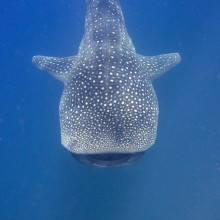
20:45 - Whale sharks - stars of the sea
Whale sharks - stars of the sea
with Brad Norman, Ecocean
Brad Norman from Ecocean, a research group based in Australia, tells us about his pioneering work tracking whale sharks in Australia's Ningaloo Reef and beyond, taking inspiration from the stars.
Like a whale-shark version of fingerprints, they have unique patterns of spots that can be mapped using star-spotting algorithms. Brad describes the tools Ecocean have developed to manipulate photographs taken at any angle allowing them to rapidly and reliably pin down the identity of whale sharks .
Sadly, you can make a lot of soup from a single whale shark fin so it's no surprise there's a giant price tag on their giant fins. But Brad and his colleagues have shown that whale sharks can be worth far more kept alive in the oceans since they return many times to the same site where tourists happily pay for the experience of swimming alongside them.
Ecocean promote a sustainable model for whale shark ecotourism, offering a win-win situation for people and sharks.
If you're lucky enough to spot a whale shark in the wild, you can get involved by sending your photos to the Ecocean project.
 Find out more
Find out more
Ecocean
Arzoumanian, Holmberg and Norman et al (2005).
An astronomical pattern-matching algorithm for computer-aided identification of whale sharks Rhincodon typus. Journal of Applied Ecology.
Whale shark (Rhincodon typus) info at the
Florida Museum of Natural History
Whale Shark Project,
The Shark Trust
Brad - Yeah for sure. I'm glad you're equally as excite about whale sharks as I am. Because I've been working on them since about 1995 and they're a beautiful creature and one that's threatened so we needed to learn more about them.
So the initial studies that I undertook were trying to identify individuals and work out how many whale sharks are at Ningaloo Reef in Western Australia and if the same ones come back and if in fact they're moving other places because so little is known about them.
They've got spots on their skin. Along with many other animals sometimes you can identify the animals through these natural markings. So I proceeded to take tens, hundreds, thousands of photographs and worked out by eye which individual sharks were which and whether we got matches.
That became a little be onerous, a little bit problematic, when you get thousands of photos.
I was very fortunate to link up with a couple of colleagues, Jason Holmberg who's a software engineer, and a good friend of his who's now a good friend of mine, Zaven Arzoumanian, who's a NASA astrophysicist. Zaven works on identifying start patterns in the night sky using a particular algorithm.
We bounced around ideas and came up with idea that we might be able to use an adaptation of this algorithm that the Hubble space telescope scientists used to identify stars in the night sky, we might be able to adapt that to basically identify individual sharks. It's sort of like a bit of fingerprint technology, really.
And it's worked brilliantly. We've got many, many whale sharks in the library and many we can prove are coming back to Ningaloo Reef and other parts of the world using this system.
Helen - Presumably you have to be able to get around problems like if you've taken the photograph from, say, different angles, maybe in different light conditions and so on.
Brad - The software, the way the system works, basically it deals with the angles between triangles of spots in an area behind the gills. Now that's great if you're side on the animal at 90 degrees and those triangles, those hundreds of triangles that the programme will draw of the pattern of spots, that will work perfectly.
But when you're not at 90 degrees to the side of the animal and you're taking a photo from behind or in front or below or above those angles get a bit screwed because of your angle to the shark.
So, with actually come up with, well, it's not me, but a gentleman called Seth Ladiger, who's another programmer. He's come up with a system where we use 3D modelling. We take a photograph, put that photograph on a virtual 3D model of a whale shark. We then move the whale shark to be at 90 degrees and then we unwrap the photograph again. And what will happen is the angles will be what they would have been if you took the photo at 90 degrees. So it allows us to actually use those photographs that might not normally have been able ot be used. And it's working really well.
Helen - Do we know if those patterns change during the lifetime of an individual whale shark or do they really stay the same from when they're quite young to when they're much older?
Brad - Bearing in mind that when the whale sharks are born, they're very small. They're only half a metre in length. They can get up to, believed to be up to 20 metres. So, this is the beauty of the triangle system that we use. Although the animal will grow, the angles between the triangles that are drawn between all these spots, they will move equally as well so we don't see any change in the angles between the spot patterns over a period of time.
Helen - Wonderful, and what sort of things are you finding out from these tracking studies? What are we learning about the lives of whale sharks?
Brad - This system is letting us monitor the number of whale sharks that are coming to different locations. We started at Ningaloo Reef in Western Australia, but the Ecocean library is now expanded to receive photographs of whale sharks in 45 different countries now. So it's actually giving us a global monitoring programme for these species.
The long term study that we started at Ningaloo has shown us that may of the same whale sharks are coming back every year which is a great sign. Lots of new ones as well, which is really positive because it is regarded as vulnerable to extinction, their number shave been declining dramatically over the years.
What we've done in Australia is show that ecotourism can be an economic as well as an ecologically sustainable alternative to the once only value of killing a whale shark for fins.
But it's very, very important that it's not just an open slather and hundreds of licenses or boats potentially interfering with their natural activities. There's some basic things - you don't touch a whale shark, you don't get in their way, you don't have too may people around the animal, and you keep boats well clear.
Helen - A really important part of the Ecocean project, it seems, is drafting in the help of members of the public. Anyone lucky enough to spot a whale shark in the wild and catch it on camera can send the photos into the Ecocean photo library. Have you got any tips for taking useful photographs?
Brad - The simple thing to know is preferably be side on to the animal. The area we're mainly using for photo identification is the area behind the gills just above the pectoral fin.
As a scientist, myself and my colleagues can only be in one place, one day of the year. But we can have, and we are getting thousands of ecotourists that are becoming our research assistants. Their input is a really major part of our global monitoring system and we really appreciate it.
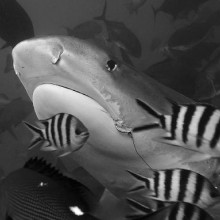
26:41 - Critter of the Month - Tiger Shark
Critter of the Month - Tiger Shark
with Boris Worm, Dalhousie University
Those powerful and endangered predators, tiger sharks, feature as our Critter of the Month.

Find out more
The Worm lab
Tiger shark (Galeocerdo cuvier) info from the
Florida Museum of Natural History
Boris - My name is Boris Worm, I'm a marine biologist working out of Dalhousie University in Halifax, Nova Scotia, Canada. And the species I'd like to choose is the tiger shark.
It's a particularly large shark up to 7 metres in length. I find all sharks incredibly interesting and cool and I'm also concerned about them because a lot of the large sharks seem to be declining very rapidly throughout the ocean. Maybe one third of all sharks tend to be threatened by extinction and this is mostly due to the effects of fishing.
Sharks have survived for a very long time in the oceans. They have been around for probably more than 400 million years. That's more than twice as long as dinosaurs on average. And they tend to play an important role in the ecosystem.
Tiger sharks, for example, live worldwide in the tropics and the sub tropics. And it has been shown that whenever they show up in an ecosystem, for example in Shark Bay in Western Australia, they tend to rearrange the distribution of other animals. Dolphins, dugongs, sea turtles, even sea birds, do different things when a tiger shark is around. And the net result of that is that those species are feeding in different locations and this has ripple effects throughout the ecosystem.
For example sea turtles, which the tiger shark can prey on because it has very powerful jaws tend to not graze so much in interior of seagrass meadows and thereby those meadows can regenerated from the grazing pressure from those large grazers, much like wolves change the distribution of deer and other grazing animals on land.
So the tiger shark is just an incredible interesting and wild animal and I'm concernd for it because it is declining throughout much of its range.











Comments
Add a comment